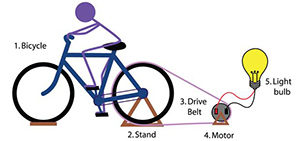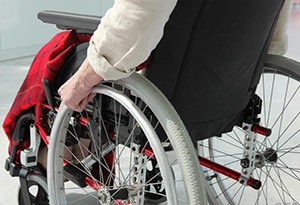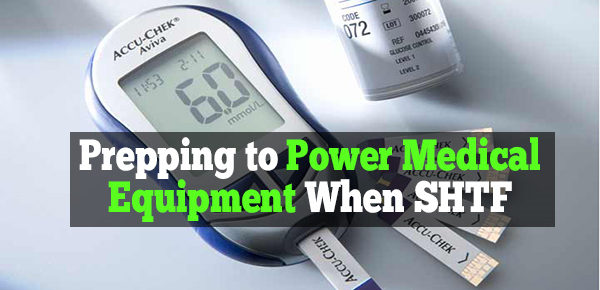By Russ Fuller
This is the second article from the 7-week series on prepping for disabled and elderly. Here is the first article from this series.
In the first part of this series on disabled/elderly prepping, we discussed the importance of having a bugout bag and a medical bugout bag. We also discussed the importance of network of individuals that can be used to help disabled/elderly individuals in a Crap Hits the Fan (CHTF) situations. In Part two, we will discuss electricity/energy needs for those that are elderly or disabled.
In many instances, disabled individuals (and some elderly individuals) have more critical and life-threatening electrical/energy needs when it comes to durable medical equipment. This durable medical equipment could include oxygen generators, ventilators, C-PAP/Bi-PAP machines, IV delivery systems, and much more. Caring for individuals with these requirements can be challenging at best. Much like the physical differences between each disabled or elderly person, prepping is different for each person because it is based on their individual needs.
Related: Prepping for Disabled and Elderly Populations (part I)
Whether you are the disabled/elderly individual or someone that will take care of them, you must ask yourself how you are going to support important equipment should there be a grid down situation. In today’s world, we rely on electricity for many of our day to day needs. This reliance goes even further for those with disabilities. One of the first things we should do is determine exactly what items need power, and what the power requirements are of that equipment. Some key things to consider when planning energy for a disabled and the elderly are:
- What devices or durable equipment will need electricity?
- Does the device run on DC power, AC power, or both?
- How much electricity does it use per day?
- How many hours per day is it needed?
- How many days, weeks, or months will I need to run this device(s)?
- How much fuel to create electricity can I stockpile (gas, propane, solar, etc.)?
- What can I afford?
- What happens if I do not have this energy?
Once you determine the device(s) needed, contact someone familiar with electricity to help you understand your absolute minimum power needs. This will help you make a decision in how to supply the energy you may need. You will then need to determine how many hours per day you need that electricity. If you are supporting a ventilator or oxygen concentrator, you may need these devices 24 hours per day, seven days per week. If you are considering a C-PAP/Bi-PAP machine, you may only need that six to eight hours per night. A mobility chair may only need three hours per day, while a nebulizer may require only one hour per day (20 minutes, three times per day).
You should also consider if the device uses batteries that either run the device (such as scooters, mobility chairs, etc.) or has a backup battery. If the devices use batteries, you should have spare backup batteries. Depending on the type of battery and the importance of the device, you may even want to have several spares around. Make no mistake, having these spare batteries could be an expensive proposition. In a mobility scooter, it is not uncommon for the batteries to cost over $150 for a pair with some going as high as $300. Even when considering the price, it beats the alternative of having a large piece of metal, fiberglass, and wheels sitting outside or in a corner being useless and taking up space. Some suggest that keeping these rechargeable batteries on a trickle charger extends their life and the window of usability, while others claims it shortens the life of the battery. You will have to do your own research to better understand which method you will follow.
Related: How to Get Power Out of Your “Dead” Batteries
Before going into details of power options and their expense, there is one last thing to consider; what might happen if we do not have the power to support these devices? This should drive how important a back-up power system is. If it is life-threatening, then perhaps it’s time to quit buying additional beans and rice, a new firearm, additional ammo, or whatever else you may be buying, and start putting the money back to provide life-sustaining energy. If you are going to live a poor quality life or not live at all, what benefit do those other items provide?
When we look at durable medical equipment, we should realize that some equipment has an option of running on 12v. DC power. You would need to check the instruction manual, a website, or contact the manufacturer to verify whether your specific piece of equipment falls within that realm. If it does, any car battery that holds a charge could be used; however eventually the energy would be drained unless recharged. For a period of time these items could be charged using a vehicle, providing the vehicle is started prior to the battery going dead. There are also jump starter boxes that could be used for the short-term, but these will run out as well.  One method that has been used in third world countries involves connecting an alternator to an exercise bicycle and charging a battery through an able bodied person pedaling the bike. All of these are methods for devices that do not need to be continually running. Continually running devices create a different problem altogether. If any of the equipment is supported by a DC adapter, and you have a way to adequately charge the battery, this may be a cheaper option than buying a generator or an entire solar system. Then again, if it is a ventilator that you are trying to power, perhaps a combination of solar and a generator is more practical for your needs. You will need to weigh your options and requirements to decide if powering the device through DC power is viable. Of course, one can only buy what you can afford, so if you are a handy person, perhaps you could build a windmill generator, or you could find what you need at a reduced price on Craigslist or at a local or eBay auction rather than use DC power.
One method that has been used in third world countries involves connecting an alternator to an exercise bicycle and charging a battery through an able bodied person pedaling the bike. All of these are methods for devices that do not need to be continually running. Continually running devices create a different problem altogether. If any of the equipment is supported by a DC adapter, and you have a way to adequately charge the battery, this may be a cheaper option than buying a generator or an entire solar system. Then again, if it is a ventilator that you are trying to power, perhaps a combination of solar and a generator is more practical for your needs. You will need to weigh your options and requirements to decide if powering the device through DC power is viable. Of course, one can only buy what you can afford, so if you are a handy person, perhaps you could build a windmill generator, or you could find what you need at a reduced price on Craigslist or at a local or eBay auction rather than use DC power.
 Those who rely on mobility devices such as scooters, power wheelchairs (and similar devices) could suffer quality of life issues if there is no power. In some cases, mitigation measures can be taken by finding equipment that only uses manpower rather than electricity. A resourceful person could go to an auction and find a manual wheelchair that is still serviceable for $20. While it may not be as comfortable and convenient as a power wheelchair, it is still functional. The addition of a few pieces of foam padding from the local hobby store or pillows from a different store may change the comfort level of the person occupying it. It should be noted that planning for a CHTF situation where no parts are available make a backup plan a must.
Those who rely on mobility devices such as scooters, power wheelchairs (and similar devices) could suffer quality of life issues if there is no power. In some cases, mitigation measures can be taken by finding equipment that only uses manpower rather than electricity. A resourceful person could go to an auction and find a manual wheelchair that is still serviceable for $20. While it may not be as comfortable and convenient as a power wheelchair, it is still functional. The addition of a few pieces of foam padding from the local hobby store or pillows from a different store may change the comfort level of the person occupying it. It should be noted that planning for a CHTF situation where no parts are available make a backup plan a must.
The fuel to power the device is also important. If you decide you need an AC generator, you need to determine how many days can you run that generator. Some individuals plan to support higher electrical requirements of some durable medical equipment by keeping a generator on hand. There are positives and negatives to this style of prepping, especially for people that have continual power needs to stay alive. In the short-term, using a generator can be a positive solution. On the negative side, even preppers have a limited supply of fuel to support a generator. Even if you have large amount fuel to power a generator, that fuel could deteriorate or lose its potency (especially if stockpiled and not rotated) or run out. When looking at fuel consumption, a 17kw automatic propane generator from a brand name manufacturer uses approximately 47 gallons per day under a full load. Of course, with a light load it is possible that fuel consumption could drop as low as 20 gallons of propane per day. Even using only 20 gallons per day, a 1,000-gallon propane tank would last only 50 days. Looking at a name brand (and an off brand generator), the average gasoline consumption was approximately 12 gallons per day. Most people do not keep 1,000 gallons of gasoline hanging around, but if they did (and it was still a usable fuel), then the generator could provide roughly 83 days of energy. The takeaway is that a gas generator should only be considered as a short-term solution.
If you are a handy and innovative person, you may be able to convert an old generator into a small wood gasifier generator. If you plan on running it long-term, this might be the best option providing you have the spare repair parts that might be needed in the event that there is a mechanical problem. You would have to consider whether you have enough material to burn to run a wood gasifier system connected to a generator. Providing you have enough wood to support it, this could run for years if there are no mechanical problems.
Related: 7 Things That Will Survive an EMP
A secondary option for continual power is to purchase a cheap solar system and multiple batteries. One retail tool company offers a small system and with all of the necessities to create power, the cost is between $300-$500. The difference in price can occur based on which configuration was used. It should be noted that if a solar system is chosen it would require an able bodied person to assemble and maintain the system. There are also long-term maintenance costs in testing the batteries to make sure they still hold a charge and the system is working properly. When considering energy needs, we should not forget the long-term costs. If the funding is available, a person could create two separate systems in case one was not operational or had a failure. If these redundant systems were identical, the first system to fail could be used as parts for the one still operating.
Some individuals have built multiple redundancies to provide electricity for medical equipment which include a generator and not one, but two separate solar systems. Of course this would be an expensive project, but when it comes to keeping our loved ones alive and with a good quality of life, this may be a possible option, providing the funding is readily available.
Other options such as wind generators, hydroelectric generation, and other non-traditional power methods should also be investigated. These systems would need to be evaluated for their effectiveness based on where you live and the availability of the resources needed to support that specific option.
As we close this week’s series, you should realize that providing the energy needs for life-sustaining and/or quality of life equipment can be an important factor. By prepping for the worst, you can in reduce your work load and providing an acceptable quality of life for yourself or the disabled or elderly loved ones in your life. Next week we will discuss prepping for those with mobility impairments and how to identify problems and potentially mitigate them.
Prepping Tips for the Disabled
H2O Dynamo – The Awesome Device That Turns Air Into Fresh Water! (Video)
50 Days of ‘Survival’ Calories with Rice and Beans
Scare Them Off Or Shoot Them Dead?
EMP Myths and Facts. What’s BS and What’s True?
About the Author: Russ Fuller is not this contributor/authors real name. The author is an avid prepper who is well-known in the public safety field. He uses a pen name to protect his identity due to the stigma that surrounds prepping and survival from those that are not preppers. He feels this stigma could damage his reputation, credibility, and his employment in public safety. In his job, he helps disabled and elderly individuals prepare for short-term disasters and is considered a subject matter expert in the field.
Disclaimer: The information contained in this series is for informational purposes only. A medical professional should be consulted before taking any actions. It should also be noted that due to the varying levels of knowledge among preppers, this series will explain the most basic actions that can be taken through advanced levels of preparedness.













Do you have any video of that? I’d like to find out
more details.
Hi Equipment,
I am assuming you mean video of the wood gas generator? If so, there is a good video of one located at https://www.youtube.com/watch?v=a6e3CprVTi8 but if you were referring to something else, please let me know